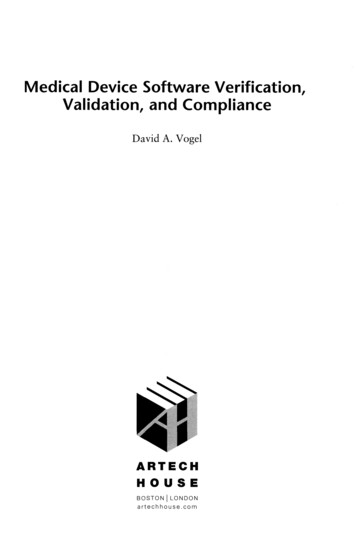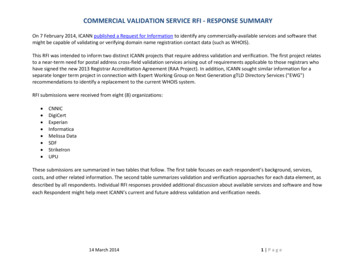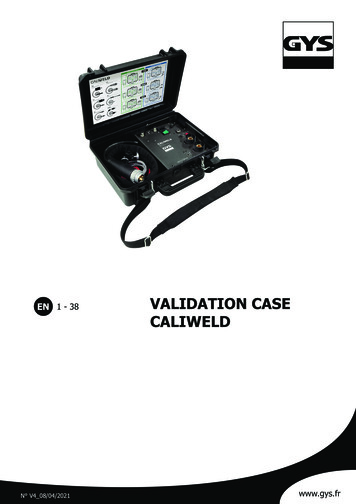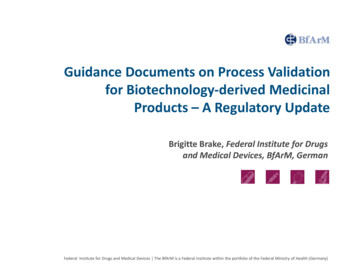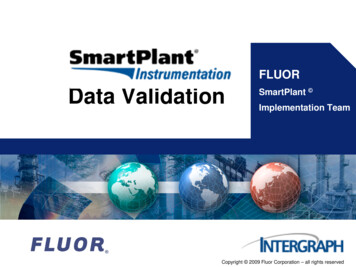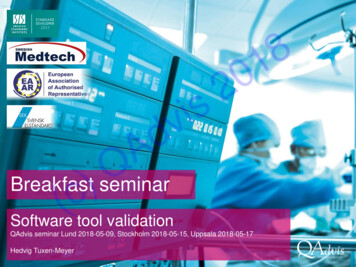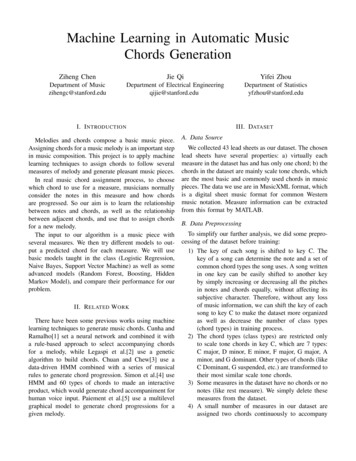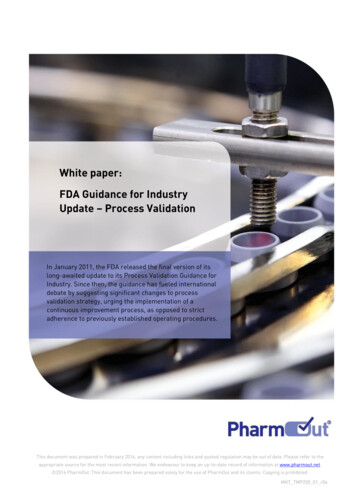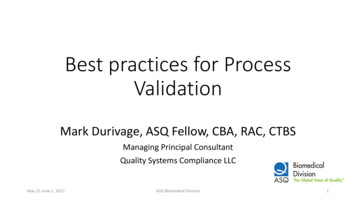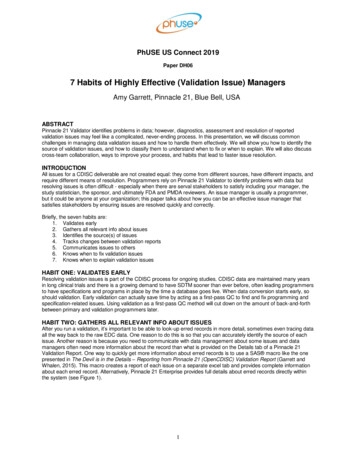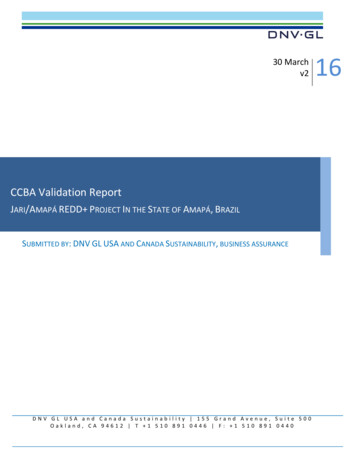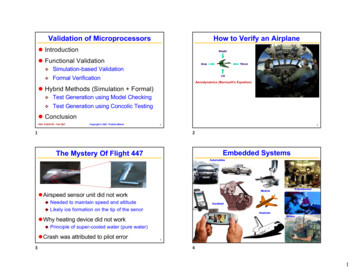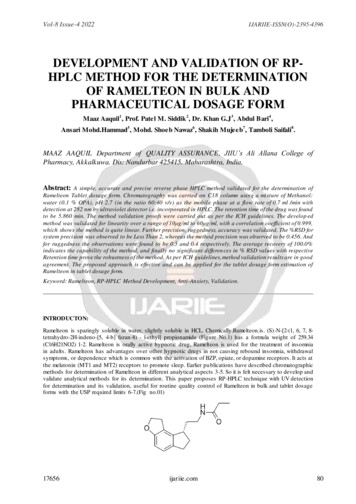
Transcription
Vol-8 Issue-4 2022IJARIIE-ISSN(O)-2395-4396DEVELOPMENT AND VALIDATION OF RPHPLC METHOD FOR THE DETERMINATIONOF RAMELTEON IN BULK ANDPHARMACEUTICAL DOSAGE FORMMaaz Aaquil1 , Prof. Patel M. Siddik 2 , Dr. Khan G.J 3 , Abdul Bari4 ,Ansari Mohd.Hammad5 , Mohd. Shoeb Nawaz6 , Shakih Mujeeb7 , Tamboli Saifali8 .MAAZ AAQUIL Department of QUALITY ASSURANCE, JIIU’s Ali Allana College ofPharmacy, Akkalkuwa. Dis: Nandurbar 425415. Maharashtra, India.Abstract: A simple, accurate and precise reverse phase HPLC method validated for the determination ofRamelteon Tablet dosage form. Chromatography was carried on C18 column using a mixture of Methanol:water (0.1 % OPA), pH 2.7 (in the ratio 60:40 v/v) as the mobil e phase at a flow rate of 0.7 ml /min withdetection at 282 nm by ultraviolet detector i.e. incorporated in HPLC. The retention time of the drug was foundto be 5.860 min. The method validation proofs were carried out as per the ICH guidelines. The develop edmethod was validated for linearity over a range of 10μg/ml to 60μg/ml, with a correlation coefficient of 0.999,which shows the method is quite linear. Further precision, ruggedness, accuracy was validated. The %RSD forsystem precision was observed to be Less Than 2, whereas the method precision was observed to be 0.456. Andfor ruggedness the observations were found to be 0.5 and 0.4 respectively. The average recovery of 100.0%indicates the capability of the method, and finally no significant differen ces in % RSD values with respectiveRetention time prove the robustness of the method. As per ICH guidelines, method validation results are in goodagreement. The proposed approach is effective and can be applied for the tablet dosage form estimation ofRamelteon in tablet dosage form.Keyword: Ramelteon, RP-HPLC Method Development, Anti-Anxiety, Validation.INTRODUCTON:Ramelteon is sparingly soluble in water, slightly soluble in HCL. Chemically.Ramelteon.is. (S)-N-[2-(1, 6, 7, 8tetrahydro-2H-indeno-[5, 4-b] furan-8) - l-ethyl] propionamide (Figure No.1) has a formula weight of 259.34(C16H21NO2) 1-2. Ramelteon is orally active hypnotic drug, Ramelteon is used for the treatment of insomniain adults. Ramelteon has advantages over other hypnotic drugs in not causing rebound insomnia, withdrawalsymptoms, or dependence which is common with the activation of BZP, opiate, or dopamine receptors. It acts atthe melatonin (MT1 and MT2) receptors to promote sleep. Earlier pu blications have described chromatographicmethods for determination of Ramelteon in different analytical aspects 3-5. So it is felt necessary to develop andvalidate analytical methods for its determination. This paper proposes RP-HPLC technique with UV detectionfor determination and its validation, useful for routine quality control of Ramelteon in bulk and tablet dosageforms with the USP required limits 6-7.(Fig no.01)17656ijariie.com80
Vol-8 Issue-4 2022IJARIIE-ISSN(O)-2395-4396Figure no 01 : Chemical Structure of RamelteonMaterial and Method:Table No.:01 Drug and Drug SupplierName of DrugDrug SupplierRAMELTEON (API)Swapnroop drug and pharmaceutical,AurangabadRAMELTEON (8mg)Obtained from local pharmacyTable No.02: List of Reagent and chemicalSr. No.Name of chemicalsManufacturer.1.Acetonitrile(HPLC grade)2.Methanol(HPLC grade)Ortophosphoric Acid3.4.(HPLC grade)water(HPLC grade)Selection of formulation:From the literature survey and market survey we selected Maxide formulation for work.Marketed Preparation:Table No.03: List of brand names of combined formulations of RamelteonStockpreparations:Sr.No1.Brand nameRozeremFormulationAvailable strengthAddress ofmanufacturerTabletRamelteon 8 mgTakedaPharmaceutical Stock I : Standard Sample Preparation :Std. RAMELTEON 10 mg in 10 ml Methanol 1000 µg/ml Stock II : Tab solution Preparation: Take 0.3 ML in 10 ml Methanol i.e. 30 µg/ml Tab solution forinjectionFor Accuracy Solution Preparations: Take 10 µg/ml TAB SOLUTION FOR AUURACY, 80 % 0.1 ml tab solution and add 8 µg/ml std rm and make up vol 10 ml with mobile phase 100 % 0.1 ml tab solution and add 10 µg/ml std rm and make up vol 10 ml with mobile phase 120 % 0.1 ml tab solution and add 12 µg/ml std rm and make up vol 10 ml with mobile phaseInstruments and Equipment’s17656ijariie.com81
Vol-8 Issue-4 2022IJARIIE-ISSN(O)-2395-4396Table. 04: Instrument (HPLC) Details used during Method DevelopmentSR. nName of InstrumentCompany Name1HPLC InstrumentAgilent with auto sampler(DAD) al Technologies Limited3Column(C18 )Agilent C18 (250mmX 4.6mm,5µm)4pH meterVSI pH meter(VSI 1-B)5BalanceWENSAR High Resolution Balance.6SonicatorUltrasonic electronic instrumentEXPERIMENTALSelection of Analytical Technique HPLC was selected as analytical technique for estimation of RamelteonInstruments:The analysis of the drug was carried out on Agilent Tech. Gradient System with Auto injector, DADDetector. Equipped with Reverse Phase C18 (Agilent) with 250mm x4.6; (5µm), UV730D Absorbancedetector and running chemstation 10.1 software.a) Selection of stationary phase : The column used in this method C18 Agilent The configuration of the column is 4.6 x 250 mm, particlesize 5 m. C18 column gives high non polar retentively, symmetric peak shape, highly reproducible andstable ideal for HPLC methodb) Solubility Studies:This study was carried out to find an ideal solvent in which drugs are sparingly soluble in watersoluble. Various solvents were tried for checking solubility of Ramelteon. From solubility studies itwas concluded that of Ramelteon is slightly soluble in HCL.c) Chromatographic conditions : The following chromatographic conditions were established by trial and error and were kept constantthroughout the experimentation.Table No.05: chromatographic conditions (HPLC) details used during method Development.1.HPLC2.SoftwareAgilent Tech. Gradient System with Autoinjectorchemstation 10.13.Column(Agilent) C18 column (4.6mm x 250mm4.Particle size packing5 m5.Stationary phaseC18 (Agilent)6.Mobile PhaseMethanol: water (0.1 % OPA)60 : 4017656ijariie.com82
Vol-8 Issue-4 2022IJARIIE-ISSN(O)-2395-43967.Detection Wavelength280 nm8.Flow rate0.7 ml/min9.TemperatureAmbient10.Sample size20 l11.pH2.712.Run Time15 min13.Filter paper0.45 mStudy on the chromatographic conditions of Ramelteon:Accurately weigh and transfer 5 mg Ramelteon working standard into 10 ml volumetric flask as about diluteMethanol prepared in completely and make volume up to the mark with the same solvent to get 500µg/mlstandard (stock solution) and 15 min sonicate to dissolve it and from the resulting solution 0.1ml was transferredto 10 ml volumetric flask and the volume was made up to the mark with mobile phase Methanol:(0.1%OPA)Water solvent. The resulting 10µg/ml of solution was subjected to chromatographic analys es using mobilephases of different strengths with chromatographic conditions mentioned below: Analytical column : Agilent C18 Column (250mm x 4.6mm), 5µm particle size.Injection volume : 20µlFlow rate: 0.7 ml/minDetection: 280nmRun Time: 10 minMETHOD DEVELOPMENT OF HPLC: List of Mobile Phase:Table No.06: Selection of mobile Phase .Sr .No.Mobile Phase1.Methanol 0.1% (OPA)Water, (80 20% v/v)20 Mcg, C18 (Agilent) (4.6mm x 250mm)2.Methanol 0.1% (OPA)Water, (70 30% v/v)20 Mcg, C18 (Agilent) (4.6mm x 250mm)3.Methanol 0.1% (OPA)Water, (60 40% v/v)20 Mcg, C18 (Agilent) (4.6mm x 250mm)4.Methanol 0.1% (OPA)Water, (50 50% v/v)20Mcg C18 (Agilent) (4.6mm x 250mm)5.17656Methanol 0.1% (OPA)Water, (40 60% v/v)20 Mcg, C18 (Agilent) (4.6mm x 250mm)ijariie.com83
Vol-8 Issue-4 2022IJARIIE-ISSN(O)-2395-4396Preparation of standard stock solution: Ramelteon standard stock solution: (Stock I)An accurately weighed quantity, 5 mg of Ramelteon (RM) was dissolved in Methanol and water in a 100mlvolumetric flask and volume made up to 10.0 ml to produce a solution of 100 μg/ml. Preparation of Stock Standard Solution :( Stock II)Accurately weight and transfer 5 ml Ramelteon working standard into 10 ml volumetric flask as about diluentsMethanol completely and make volume up to the mark with the same solvent to get 500µg/ml standard (stocksolution) and 15 min sonicate to dissolve it and the resulting stock solution 0.1ml was transferred to 10 mlvolumetric flask and the volume was made up to the mark with mobile phase Methanol: Water (0.1%OPA)Water, prepared in (60 ml MEOH: 40ml WATER v/v)Validation of method for analysis of Ramelteon: The developed method was validated as per ICH guidelines .Linearity:Linearity of an analytical method is its ability to elicit test results that are directly or by a well-definedmathematical transformation, proportional to the concentration of analyte in sa mples within a given range, TheResult are shown in;(Table No.07 ) Determination:The linearity of the analytical method is determined by mathematical treatment of test results obtained byanalysis of samples with analyte concentrations across the claimed range. Area is plotted graphically as afunction of analyte concentration. Percentage curve fittings are calculated. Acceptance Criteria:The plot should be linear passing through the origin.Correlation Coefficient should not be less than 0.999. Preparation of standard stock solution for linearity:Average weight of tablet sample (equivalent to 10 mg of Ramelteon were weighed and transferred to 10 mlvolumetric flask & diluent was added to make up the volume. Sonicated for 10 min with occasional swirling. 0.1ml of this solution diluted up to 10 ml volumetric flask with diluents was added to make up the volume. Preparation of linearity solution:A series of standard preparations of working standard of were prepared.Table No.07: Table of linearity for RP-HPLC MethodLinearity of RamelteonHPLCSr .No.Concentration(µg/ml)110220330440560Accuracy (recovery):The accuracy of an analytical method is the closeness of test results obtained by that method to the true value.Accuracy may often the expressed as percent recovery by the assay of known added amounts of analyte. Theaccuracy of an analytical method is determined by applying the method to analyzed samples, to which knownamounts of analyte have been added. The accuracy is calculated from the test results as the percentage of analyterecovered by the assay, The RP-HPLC& UV Method Result are shown in; (Table No:18)17656ijariie.com84
Vol-8 Issue-4 2022IJARIIE-ISSN(O)-2395-4396Preparation of standard stock solution:10 mg of Ramelteon working standards were weighed and transferred to 10 mL volumetric flask & diluent wasadded to make up the volume 0.1 ml of this solution diluted up to 10 ml with diluent.Application of proposed method for analysis of tablet formulation:AccuracyThe accuracy was determined by Ramelteon (equivalent to 10 mg (80 %, 100 % and 120 % of the label claimed,respectively) to quantity equivalent to average weight of marketed tablets. This powder containing 10 mg ofRamelteon were triturated and then subjected to chromatographic analysis using the described method. Theresulting was analyzed in triplicates over three days. The % recovery of added drug was taken as a measure ofaccuracy.The Result are shown in; (Fig No:11)Repeatability:Precision of the system was determined with the sample of RP-HPLC& UV Method for. Three replicates ofsample solution containing 20 mg of Ramelteon were injected and peak areas were measured and %RSD wascalculated. Is was repeated for five times result are shown in; (Table No: 12) & (Fig No: )Application of proposed method for analysis of tablet formulation:Average weight of tablet sample (equivalent to 10 mg of Ramelteon) was weighed and transferred to 10mLvolumetric flask & diluent was added to make up the volume. Sonicated for 10 min with occasional swirling.The above solution was filtered through 0.45μm membrane filter 0.1 ml of this solution diluted up to 10 ml withdiluent.Precision:Precision of an analytical method is the degree of agreement among Individual test results when the procedure isapplied repeatedly to multiple Samplings of a homogenous sample. Precision of an analytical method is usuallyexpressed as standard deviation or relative standard deviation. Also, the results obtained were subjected to oneway ANOVA and within-day mean square and between-day mean square was determined and compared usingF-testRobustness:The mobile phase composition was changed in ( 1 ml/ min -1 ) proportion and the flow rate was of Methanol :Water (0.1 % OPA ) in the mobile phase composition ( 1ml/ min -1 ) and the change in detection wavelength ( 1ml/ min -1 ) and the effect of the results were examined and it was performed using 20µg/ml solution ofRamelteon in triplicate. The Result are shown in; (Table No: 31)Detection LimitBased on the S.D. of the response and the slope of calibration curve, the detection limit (DL) was calculated as,3.3σDL SWhere,σ the S.D. of the y-intercepts of regression lines.S the slope of the calibration curve.The slope S may be estimated from the calibration curve and S.D. was used should be calculated from the y intercepts of regression line in calibration curve.The result is shown in: (chapter: 8)Quantitation LimitBased on the S.D. of the response and the slope of calibration curve, the quantitation limit (QL) was calculatedas,10σQL SWhere,σ the S.D. of the y-intercepts of regression lines.S the slope of the calibration curve.17656ijariie.com85
Vol-8 Issue-4 2022IJARIIE-ISSN(O)-2395-4396The slope S may be estimated from the calibration curve and S.D. was used should be calculated from the y intercepts of regression line in calibration curve.The results are shown in (chapter: 8)Analysis of marketed formulationTo determine the content of Ramelteon in marketed tablets (label claim 8mg of Ramelteon ), 20 tablets powderweighed in 15.74gms and average weight of powder was calculated in 787gms.Tablets were triturated andpowder equivalent to weighed in 6.55 mg The drug was extracted from t he tablet powder with 10 ml Methanol .To ensure complete extraction it was sonicated for 15 min. 0.1mL of supernatant was then diluted up to 10 mlwith mobile phase. The resulting solution was injected in HPLC and drug peak area was noted . (Fig No: 66).Regression equation was generated using peak areas of standard solutions. Using the regression equation andpeak area of the sample the amount of Ramelteon in the sample was calculated. The amount of Ramelteon pertablet was obtained from the regression equation of the calibration curve as described in analysis of Tabletformulation are shown in (Table No.32).RESULTS AND DISCUSSION:Preliminary studies on RamelteonMelting pointThe procured reference standard of Ramelteon was found to melt in the range of 1130 C to 1150 C.Solubility:The drug was found to be Sparingly Soluble in Water. Slightly Soluble in HCLUV SpectroscopyStandard solutions were scanned in the range of 200-400nm ,against 10 ml methanol and volume make withwater solvent system as reference Ramelteon in water was found to be selected wavelength is 280 nm .(FigureNo:19)Sample-12(282.0, 0.5996)Absorbance(Abs)3(204.0, 2.0395)1.9959)(212.0, g No.02: UV Spectrum of RamelteonFig No 03: Chromatogram of Final TrialTable.No.15. Trial-3 of chromatogram of rea%TPTF86
Vol-8 Issue-4 .006986.01.2273Analytical of Method Validation:1. Linearity:From Ramelteon standard stock solution, different working standard solution (1060μg/ml) were prepared in mobile phase 20 μl of sample solution was injected into thechromatographicsystemusing mixed volume loop injector Chromatograms were recorded. The area for each concentration was recorded (Table No. 09) The Calibration curves are shown in [Fig. No.04]Fig.No.04. Chromatogram of linearityTable No 09. Linearity of RamelteonConcentration 35121366.10191787.94832705.7900Sr. No.12345Fig.No.05. Calibration curve of Ramelteon for HPLC methodAxis TitleRAMELTEONy 44.427x 30.891 4000.00002000.0000Series10.0000050100Linear (Series1)Axis TitleTable No 10. Regression equation data for RamelteonRegression Equation Data Y mx c17656Slope(m)44.42Intercept(c)30.89Correlation Coefficient0.999ijariie.com87
Vol-8 Issue-4 2022IJARIIE-ISSN(O)-2395-4396Linearity of Ramelteon was observed in the range of 10-60μg/ml Detection wavelength used was 280 nm. Theplot should be linear passing through the origin; Correlation Coefficient should not be less than 0.999.thatconcluded. (Table. No. 11)2. Accuracy:Recovery studies were performed to validate the accuracy of developed method. To pre analyzed tabletsolution, a definite concentration of standard drug (80%, 100%, and 120%) was added and then its recovery wasanalysed . Statistical validation of recovery studies shown in Table No.11.Result For AccuracyDrugMETHODRP-HPLCMethodLevel(% )Amt.taken(μg/mlAmt.Added(μg/mlAbsorbanceMean* S.D.Amt.recoveredMean * S.D.% RecoveryMean * S.D.80%10818.10 0.0498.10 0.049101.30 0.62100%101020.14 0.08210.14 0.082101.38 0.82120%10122.08 0.04612.08 0.046100.68 0.383. System suitability parameters :( Repeatability)To ascertain the resolution and reproducibility of the proposed chromatographic system for estimationof Ramelteon system suitability parameters were studied. The result shown in below (Table No.12)Table No.12: Repeatability studies on RP-HPLC for RamelteonSr.No.ConcentrationofRamelteon (mg/ml)150250Peak areaAmountfound (mg)2714.09460.4460.362717.286Mean% Amountfound100.74100.6560.40SD2.26% RSD0.084.Precision:The method was established by analyzing various replicates standards of Ramelteon. All the solutionwas analyzed thrice in order to record any intra-day & inter-day variation in the result that concluded. The resultobtaine for intraay is shown in ( Table No. 13) respectively.Table No .13: Result of Intraday and Inter day Precision studies on RP-HPLC Method for RamelteonConc.METHODRP HPLCMETHOD17656DrugRMIntraday PrecisionInterday Precision(µg/ml)Mean SD% Amt.FoundMean SD% Amt.Found2080.83 0.975.6280.87 0.935.7030267.33 1.1517.74271.33 1.1817.8240463.77 3.4624.36468.77 3.5524.43ijariie.com88
Vol-8 Issue-4 2022IJARIIE-ISSN(O)-2395-4396Fig No .06: Chromatogram of PrecisionIntraday and Inter day Precision studies on RP-HPLC method for Ramelteons which shows the highprecision %amount in between 5% to 24% indicates to analytical method that concluded.5. Robustness :The Robustness of a method is its ability to remain unaffected by small deliberate changes in parameters. Toevaluate the robustness of the proposed method, small but deliberate variations in the optimized methodparameters were done. The effect of changes in mobile phase composition and flow rate, wavelength onretention time and tailing factor of drug peak was studied.The mobile phase composition was changed in ( 1ml/min -1 ) proportion and the flow rate was varied by ( 1ml/min -1 ), and wavelength change ( 1 ml/min -1 ) ofoptimized chromatographic condition. The results of robustness studies are shown in (Table No.14).Robustnessparameters were also found satisfactory; hence the analytical method would be concluded.5.1 Flow Rate Change 0.6 mlFigNo.07. Chromatogram of Flow rate change 0.6ml1) Mobile phase composition Change : 59ml MEOH 41ml WaterFig No .08. Chromatogram of Mobile phase composition change: 59 ml MEOH 41ml WaterConc.Amount ofdetected(mean SD)% RSD15839.99 0.5340.39151525344.55 0.94653.7 399.41620.06 438.130.2761.1070.66Flow rate change(0.6ml)20748.25 504.8667.47Flow rate change(0.8ml)2056.06 364.4965.55sParametersMobile phase composition-(59 41)Mobile phase composition-( 61 39)Wavelength change281nmWavelength Change 283nmTable No.14 Result of Robustness Study of Ramelteon17656ijariie.com89
Vol-8 Issue-4 2022IJARIIE-ISSN(O)-2395-4396Robustness Study of Ramelteon:The changes were did flow rate ( 1 ml/ min -1 ), PH of mobile phase composition ( 1 ml/ min -1 ), and Wavelength( 1 ml/ min -1 ). %RSD for peak area was calculated which should be less than 2%.the result shown in analyticalmethod that concluded. (Table No.14)6. Limit DetectionThe LOD is the lowest limit that can be detected. Based on the S.D. deviation of the response and the slope thelimit of detection (LOD) may be expressed as:LOD Where, SD Standarddeviation of Y interceptS Slope 3.3XAvd.SD/Slope 3.3X6.90/ 44.42 0.51232The LOD of Ramelteon was found to be 0.5123 (μg/ml) analytical methods that concluded .8. Limit QuantificationThe LOQ is the lowest concentration that can be quantitatively measured. Based on the S.D. deviation of theresponse and the slope,The quantitation limit (LOQ) may be expressed as:LOQ 10 (SD)/ S 10 X 6.90s / 44.42 1.55248Where, SD Standard deviation Y intercept S SlopeThe LOQ of Ramelteon was found to be 1.5524 s(μg/ml) analytical method that concluded.Analysis of tablet formulation: Procedure:Weigh 20 Ramelteon Tablet and calculated the average weigh 500 mg accurately weigh and transferthe sample equivalent to 31.25 mg Ramelteon into 10 ml volumetric flask. Add about 10ml of diluent andsonicate to dissolve it completely and make volume up to the mark with dilu ent. Mix well and filter through0.45 µm filter. Further pipette 0.3ml of the above stock solution into a 10 ml volumetric flask and dilute up tothe mark with diluents. (25 µg/ml). The simple chromatogram of test Ramelteon Shown in (Fig No: 09) theamounts of Ramelteon per tablet were calculated by extrapolating the value of area from the calibration curve.Analysis procedure was repeated five times with tablet formulation. Tablet Assay for %Label claim for %RSDCalculated, Result was shown in (Table No. 15)Brand Name:ROZEREM 8 MG (Takeda pharmaceutical)Total weight of 20-tab wt. 500 mgAvg. Weight 0.025 mg. /TabEq.wt for 10 mg 10 X 25 / 8 31.25 mgTake 0.3 ml in 10ml Methanol i.e. 30 µg/ml tab solution for injectionSonicate 10 min i.e. 30 µg/ml RamelteonFig No.09: Chromatogram for Marketed Formulation17656ijariie.com90
Vol-8 Issue-4 dLabelClaimedRMAmt.Found3030.393030.21% LabelClaimSD100.71101.01% RSD2.780.4042.840.401Table.15. Analysis of marketed formulationAnalysis of marketed formulation were also %Label Claim was found to be 100-101% Satisfactory areconcluded. (Table No.15)Table No.16: Result of linearity of RamelteonParameterRMConcentration (µg/ml)10-60(µg/ml)Correlation Coefficient(r2)0.999Slope (m)44.42Intercept(c)30.89Table No.17: Optimized chromatographic conditions1.HPLC2.SoftwareAgilent Tech. Gradient System with Autoinjectorchemstation 10.13.Column(Agilent) C18 column (4.6mm x 250mm4.Particle size packing5 m5.Stationary phaseC18 (Agilent )6.Mobile PhaseMethanol : water (0.1 % OPA)60 : 407.Detection Wavelength282 nm8.Flow rate0.7 ml/min9.TemperatureAmbient10.Sample size20 l11.pH2.713.Filter paper0.45 mTable no 18: Result of Recovery data for Ramelteon% Level% Mean SD*80%101.30 0.62100%101.38 0.82120%100.68 0.38Table no 19: result of precision17656ijariie.com91
Vol-8 Issue-4 ay Precision(µg/ml)Mean SDRP HPLCMETHODRMInterday Precision2080.83 0.9730267.33 1.1540% Amt.Found463.77 3.46100.92100.7599.28Mean SD80.87 0.93271.33 1.18468.77 3.55% Amt.Found100.28100.8399.54Conclusion: The result was concluded that the methods developed in the present investigation are simple,sensitive, accurate, rapid and precise. Hence, the above said method can be successfully applied for theRamelteon in the tablet dosage form.Acknowledgement: The authors are sincerely thanks to Ali Allana College of Pharmacy, Akkalkuwa,Nandurbar, India for providing the facilities to complete this research work.Conflict of Interest:The author has declared no conflict of interest.Abbreviations: RP-HPLC: Reverse Phase High Performance Liquid Chromatography: Ramelteon, H2O:Water,C2H3N:Methanol,ML:M icro litre,Mg:M 17656Ahmed M, Deepak BM, Shetty SA, Kuppast IJ, Anilkumar SM, MC Ravi. RP-HPLC methoddevelopment and validation for estimation of macitentanintablet dosage form. J Pharm Pharm Sci2014; 4:881.Quality Assurance of Pharmaceuticals, A compendium of guidelines and related materials; WHO,Geneva; 1997. p. 119:24.ICH Q2 (R1) Validation of Analytical Procedure; 2005. p. 14.Ahmed M, Deepak BM, Shetty SA, Kuppast IJ, Anilkumar SM, Ravi MC. RP-HPLC methoddevelopment and validation for estimation of macitentan in tablet dosage form. J Pharm Pharma Sci2015; 4:887.Douglas A, Skoog F, James H, Stanley R C. Liquid Chromatography, In Instrumental Analysis,Cengage Learning India Pvt. Ltd, New Delhi, 9th edition, 2007, 893-934.Skoog, Holler, Crouch. Liquid Chromatography, In Instrumental Analysis, Cengage Learning India,New Delhi, 2011, 893-934.5th edition, 2010, 2.570-2.629. 5. Sharma B K. High Performance Liquid Chromatography,In Instrumental Methods of Chemical Analysis, Goel Publishers, Meerut, 24th edition, 2005, 295-300.Alfonso R G, Ara H D M, Glen R H, Thomas M, Nicholas G P, Roger L S, Steve H W.Chromatography, In Remington: The Science and Practice of Pharmacy, Lippincott Williams andWilkins: Philadelphia, 20th edition, 2000, 587-591.Adsorption Chromatographyhttp://www.separationprocesses.com/ Adsorption/ AD Chp05a.html.Adsorption Chromatography - http://cemca.org/andcollege/ and cwebsite/ subject01/ ozerem-ramelteon-342928Sijariie.com92
a) Selection of stationary phase: The column used in this method C 18 Agilent The configuration of the column is 4.6 x 250 mm, particle size 5 m. C 18 column gives high non polar retentively, symmetric peak shape, highly reproducible and stable ideal for HPLC method b) Solubility Studies:
